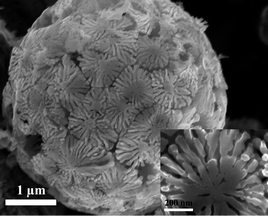Crossref Citations
This article has been cited by the following publications. This list is generated based on data provided by
Crossref.
Obrovac, M. N.
and
Chevrier, V. L.
2014.
Alloy Negative Electrodes for Li-Ion Batteries.
Chemical Reviews,
Vol. 114,
Issue. 23,
p.
11444.
Hao, Qin
Zhao, Dianyun
Duan, Huimei
Zhou, Qiuxia
and
Xu, Caixia
2015.
Si/Ag composite with bimodal micro-nano porous structure as a high-performance anode for Li-ion batteries.
Nanoscale,
Vol. 7,
Issue. 12,
p.
5320.
Legrain, Fleur
and
Manzhos, Sergei
2015.
Aluminum doping improves the energetics of lithium, sodium, and magnesium storage in silicon: A first-principles study.
Journal of Power Sources,
Vol. 274,
Issue. ,
p.
65.
Wang, Jing
Meng, Xiangcai
Fan, Xiulin
Zhang, Wenbo
Zhang, Hongyong
and
Wang, Chunsheng
2015.
Scalable Synthesis of Defect Abundant Si Nanorods for High-Performance Li-Ion Battery Anodes.
ACS Nano,
Vol. 9,
Issue. 6,
p.
6576.
Qu, Fei
Li, Chilin
Wang, Zumin
Wen, Yuren
Richter, Gunther
and
Strunk, Horst P.
2015.
Eutectic Nano-Droplet Template Injection into Bulk Silicon to Construct Porous Frameworks with Concomitant Conformal Coating as Anodes for Li-Ion Batteries.
Scientific Reports,
Vol. 5,
Issue. 1,
Feng, Jinkui
Zhang, Zhen
Ci, Lijie
Zhai, Wei
Ai, Qing
and
Xiong, Shenglin
2015.
Chemical dealloying synthesis of porous silicon anchored by in situ generated graphene sheets as anode material for lithium-ion batteries.
Journal of Power Sources,
Vol. 287,
Issue. ,
p.
177.
Hwang, Gaeun
Park, Hyungmin
Bok, Taesoo
Choi, Sinho
Lee, Sungjun
Hwang, Inchan
Choi, Nam-Soon
Seo, Kwanyong
and
Park, Soojin
2015.
A high-performance nanoporous Si/Al2O3 foam lithium-ion battery anode fabricated by selective chemical etching of the Al–Si alloy and subsequent thermal oxidation.
Chemical Communications,
Vol. 51,
Issue. 21,
p.
4429.
Xu, Caixia
Hao, Qin
and
Zhao, Dianyun
2016.
Facile fabrication of a nanoporous Si/Cu composite and its application as a high-performance anode in lithium-ion batteries.
Nano Research,
Vol. 9,
Issue. 4,
p.
908.
Borkar, T.
Gwalani, B.
Choudhuri, D.
Alam, T.
Mantri, A.S.
Gibson, M.A.
and
Banerjee, R.
2016.
Hierarchical multi-scale microstructural evolution in an as-cast Al2CuCrFeNi2 complex concentrated alloy.
Intermetallics,
Vol. 71,
Issue. ,
p.
31.
Hwang, Gaeun
Kim, Ju-Myung
Hong, Dongki
Kim, Choon-Ki
Choi, Nam-Soon
Lee, Sang-Young
and
Park, Soojin
2016.
Multifunctional natural agarose as an alternative material for high-performance rechargeable lithium-ion batteries.
Green Chemistry,
Vol. 18,
Issue. 9,
p.
2710.
Yi, Ran
Gordin, Mikhail L.
and
Wang, Donghai
2016.
Integrating Si nanoscale building blocks into micro-sized materials to enable practical applications in lithium-ion batteries.
Nanoscale,
Vol. 8,
Issue. 4,
p.
1834.
Kunduraci, Muharrem
2016.
Dealloying technique in the synthesis of lithium-ion battery anode materials.
Journal of Solid State Electrochemistry,
Vol. 20,
Issue. 8,
p.
2105.
Park, Hyeong‐Il
Sohn, Myungbeom
Kim, Dae Sik
Park, Cheolho
Choi, Jeong‐Hee
and
Kim, Hansu
2016.
Carbon Nanofiber/3D Nanoporous Silicon Hybrids as High Capacity Lithium Storage Materials.
ChemSusChem,
Vol. 9,
Issue. 8,
p.
834.
Zhou, Xiong
Han, Kai
Jiang, Heng
Liu, Zhao
Zhang, Zhifeng
Ye, Hongqi
and
Liu, Yong
2017.
High-Rate and Long-Cycle Silicon/Porous Nitrogen-Doped Carbon Anode via a Low-Cost Facile Pre-Template-Coating Approach for Li-ion Batteries.
Electrochimica Acta,
Vol. 245,
Issue. ,
p.
14.
Huang, Ting
Sun, Dingyue
Yang, Wuxiong
Wu, Qiang
and
Xiao, Rongshi
2017.
The Fabrication of Porous Si with Interconnected Micro-Sized Dendrites and Tunable Morphology through the Dealloying of a Laser Remelted Al–Si Alloy.
Materials,
Vol. 10,
Issue. 4,
p.
357.
Banek, Nathan A.
Hays, Kevin A.
and
Wagner, Michael J.
2017.
High Capacity Silicon/Multiwall Graphene Nanoshell Li-Ion Battery Anodes from a Low-Temperature, High-Yield and Scalable Green Synthesis.
Journal of The Electrochemical Society,
Vol. 164,
Issue. 7,
p.
A1569.
Jiang, Tianchan
Zhang, Ruibo
Yin, Qiyue
Zhou, Wenchao
Dong, Zhixin
Chernova, Natasha A.
Wang, Qi
Omenya, Fredrick
and
Whittingham, M. Stanley
2017.
Morphology, composition and electrochemistry of a nano-porous silicon versus bulk silicon anode for lithium-ion batteries.
Journal of Materials Science,
Vol. 52,
Issue. 7,
p.
3670.
Wang, Liangbiao
Mei, Tao
Liu, Weiqiao
Sun, Jianhua
Zhou, Quanfa
and
Qian, Yitai
2018.
Low temperature chemical synthesis of silicon nanoparticles as anode materials for lithium-ion batteries.
Materials Chemistry and Physics,
Vol. 220,
Issue. ,
p.
308.
Ryu, Jaegeon
Bok, Taesoo
Kim, Sungho
and
Park, Soojin
2018.
Fundamental Understanding of Nanostructured Si Electrodes: Preparation and Characterization.
ChemNanoMat,
Vol. 4,
Issue. 4,
p.
319.
Sohn, Myungbeom
Lee, Dong Geun
Park, Hyeong‐Il
Park, Cheolho
Choi, Jeong‐Hee
and
Kim, Hansu
2018.
Microstructure Controlled Porous Silicon Particles as a High Capacity Lithium Storage Material via Dual Step Pore Engineering.
Advanced Functional Materials,
Vol. 28,
Issue. 23,





